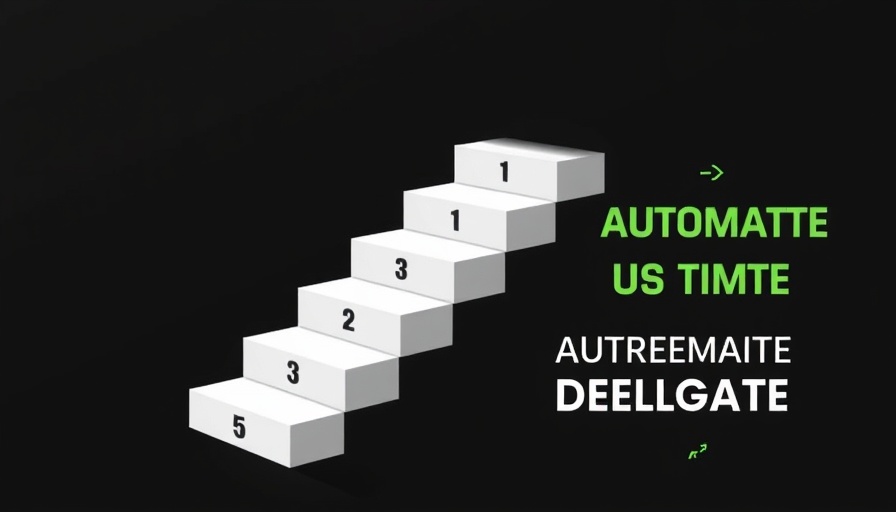
Unlocking Potential: The Power of Delegation and Automation
In today's fast-paced world, where the demands of work can quickly overwhelm even the most seasoned executives and entrepreneurs, the key to success often lies in focusing on what you do best. Whether it's strategic decision-making or fostering relationships, getting bogged down by mundane tasks can hinder your personal and professional growth. Understanding how to delegate and automate effectively can free you from these distractions, allowing you to concentrate on your core competencies and maximize opportunities.
In '5 Simple Steps to Delegate and Automate More Work,' the discussion dives into productivity strategies, exploring key insights that sparked deeper analysis on our end.
Understanding Your 'Why'
Before embarking on the journey of delegation, it's vital to establish your 'why.' Knowing the reasons behind the desire to offload tasks can keep you motivated when the process feels daunting. High flow work is one area worth focusing your energy on. Think back to the last time you totally lost track of time because you were engaged in a particularly exciting project—designing a new product or solving a complex issue. Those are the moments that fill you with joy and allow you to shine.
In fact, studies indicate that spending more time on high-impact activities leads not just to improved job satisfaction but also to better outcomes in your work. By delegating routine activities, you create space for more flow, giving you the opportunity to rediscover what makes you passionate.
Identifying Time-Wasting Activities
Once you know why delegation is important, the next step is identifying tasks that consume your time but don't generate significant returns. Greg McKeown's concept of essentialism provides a powerful lens for this. By pausing once every work hour to assess your recent activities, you can start to pinpoint those routine tasks that don't effectively contribute to your goals.
For many, this might be checking emails or organizing files. The crucial insight is to refine your focus on activities that are either high flow or high earning. As you compile a list of repeat tasks that waste time, challenge yourself to find ways to automate or delegate them effectively without giving up control over what truly matters.
Calculating the Worth of Your Time
Now that you've identified tasks worth delegating, it’s time to crunch the numbers. The 'rule of 30' from Rory Vaden’s teachings emphasizes that if you can delegate a 5-minute task by investing less than 150 minutes, it's a sound investment for your efficiency. This means examining the cost-versus-time tradeoff to see if outsourcing or automating a task actually pays off.
For instance, if you’re self-employed and earn $100,000 a year, your effective hourly rate comes out to $50. If a virtual assistant can perform routine tasks at a lower hourly rate, your investment becomes a net gain. Thinking from a future-focused perspective allows you to plan your growth strategically.
Clarity is Key: The Camcorder Method
Once you’ve decided to delegate specific tasks, clarity is paramount. Ambiguous instructions can lead to misunderstandings, increased frustration, and ultimately wasted time. The 'camcorder method' developed by Dan Martell offers a unique twist for explaining tasks—simply record yourself doing them while explaining each step. This video tutorial can then serve as both a guide and a reference for whoever you delegate to.
Following this, compile the video into a procedural document, replete with clearly defined steps and checklists. This can streamline the process and eliminate confusion, ensuring that the delegate has all the tools they need to succeed without constant oversight.
Start Small and Build Trust
The final step in the journey of effective delegation is to start small. Delegation is akin to training a rookie driver on a racetrack; you want to ensure they understand the mechanics before racing ahead. Frequent checkpoints and feedback loops, like Kenneth Blanchard’s one-minute praises and redirects, help reinforce positive progress and offer guidance on areas for improvement.
This method fosters a trusting environment where both you and your delegate can learn and adapt iteratively. Remember, it's a gradual process, and progress will come as you both adjust to new responsibilities.
Conclusion: Take Action Today!
Adopting these five essential delegation and automation steps can ensure you focus on what you excel at, ultimately contributing to both your well-being and professional success. By understanding the 'why', spotting waste, calculating the value of your time, providing clear instructions, and starting small with feedback, you'll be on your way to more efficient and joyful workdays. Ready to embrace this change? Pick one task to delegate today, and watch how it transforms your life.
If you're still hungry for more insight, click the link below to access a one-page PDF summary of these crucial steps.
 Add Row
Add Row  Add
Add 




Write A Comment